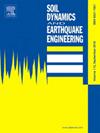日本相模湾近海地点的地震响应特性--第二部分:俯冲带地震的非线性行为和随机模拟
IF 4.2
2区 工程技术
Q1 ENGINEERING, GEOLOGICAL
引用次数: 0
摘要
尽管对海洋工程至关重要,但人们对近海场地的非线性地震响应特性仍然知之甚少。因此,模拟近海场地的地表运动是一项重大挑战。为了解决这个问题,本研究首先使用广义反演技术(GIT)获得了一个数据集,其中包括 70 次地震的应力降、特定地区的质量因子以及日本相模湾六个近海站点的线性站点放大系数(AFs)。然后,通过纳入焦深达 333 千米、峰值地面加速度(PGA)范围为 0.2 至 4.2 m/s2 的额外离岸加速度图,我们深入研究了非线性站点行为分别对高频衰减参数(κ0)和 AFs 的影响。当峰值地面加速度(PGA)达到 0.5-0.8 m/s2 时,κ0 出现了与直觉相反的下降,这与之前对 KiK 网站的研究结果类似。我们的研究结果表明,近海站点的高频衰减特性在强运动下有所不同,这可能归因于与频率无关的品质因数和近地表沉积物中的 S 波速度的非线性演变。此外,当 PGA 达到 0.2-0.3 m/s2 时,这些近海站点的非线性度(DNL)超过 4,这一临界值明显低于之前报告的 0.5-1.0 m/s2 的范围。此外,我们还观察到平直和陡峭近海站点之间非线性行为的系统性变化,特别是峰值频率分别向低频和高频移动。这些新发现可能主要归因于地形和海洋沉积物之间错综复杂的相互作用。最后,利用随机有限故障模拟方法(SFFSM)对两次俯冲地震(MW6.2 和 5.9)进行的模拟表明,在 0.1 Hz 以上频率时,模拟结果与观测结果十分吻合。值得注意的是,在 0.2-1.2 m/s2 的宽 PGA 范围内,非线性 AFs 的表现优于线性 AFs,这凸显了非线性场地行为在表征近海地动方面的重要性。这一发现增强了模拟框架(集成 GIT 和 SFFSM)有效、准确模拟近海地动的潜力。本文章由计算机程序翻译,如有差异,请以英文原文为准。
Seismic response characteristics of offshore sites in the Sagami Bay, Japan—Part II: Nonlinear behaviors and stochastic simulation of subduction zone earthquakes
Despite their crucial importance for marine engineering, the nonlinear seismic response characteristics of offshore sites remain poorly understood. Consequently, simulating ground-motion at offshore sites poses a significant challenge. To address this, this study begins with a dataset comprising stress drops of 70 earthquakes, region-specific quality factors, and linear site amplification factors (AFs) of six offshore stations in Sagami Bay, Japan, obtained using the generalized inversion technique (GIT). Then, by incorporating additional offshore accelerograms with focal depths up to 333 km and peak ground accelerations (PGAs) ranging from 0.2 to 4.2 m/s2, we delve deeper into the effects of nonlinear site behaviors on the high-frequency attenuation parameter (κ0) and AFs, respectively. A counterintuitive decrease in κ0 was observed as the peak ground acceleration (PGA) reached 0.5–0.8 m/s2, echoing similar observations from previous studies on KiK-net stations. Our results indicate that the high-frequency attenuation characteristics of offshore sites vary under strong motions, potentially attributable to the nonlinear evolution of the frequency-independent quality factor and S-wave velocity within near-surface sediments. Additionally, the degree of nonlinearity (DNL) at these offshore stations exceeded 4 when PGA reached 0.2–0.3 m/s2, a threshold significantly lower than the previously reported range of 0.5–1.0 m/s2. Furthermore, we observed systematic variations in nonlinear behaviors between flat and steep offshore stations, particularly with peak frequencies shifting towards lower and higher frequencies, respectively. These new findings may be mainly attributed to the intricate interaction of topography and marine sediments. Finally, simulations of two subduction earthquakes (MW6.2 and 5.9) using the stochastic finite-fault simulation method (SFFSM) showed good agreement with observations at frequencies above 0.1 Hz. Notably, nonlinear AFs outperformed linear ones across a wide PGA range of 0.2–1.2 m/s2, highlighting the significance of nonlinear site behaviors in characterizing offshore ground-motions. This finding reinforces the potential of the simulation framework (integrating GIT and SFFSM) for effectively and accurately simulating offshore ground-motion.
求助全文
通过发布文献求助,成功后即可免费获取论文全文。
去求助
来源期刊

Soil Dynamics and Earthquake Engineering
工程技术-地球科学综合
CiteScore
7.50
自引率
15.00%
发文量
446
审稿时长
8 months
期刊介绍:
The journal aims to encourage and enhance the role of mechanics and other disciplines as they relate to earthquake engineering by providing opportunities for the publication of the work of applied mathematicians, engineers and other applied scientists involved in solving problems closely related to the field of earthquake engineering and geotechnical earthquake engineering.
Emphasis is placed on new concepts and techniques, but case histories will also be published if they enhance the presentation and understanding of new technical concepts.
 求助内容:
求助内容: 应助结果提醒方式:
应助结果提醒方式:


